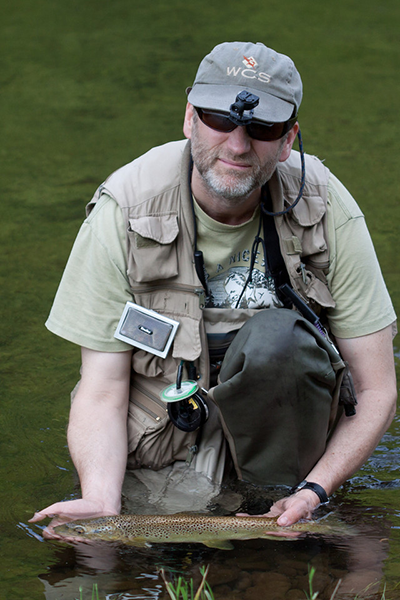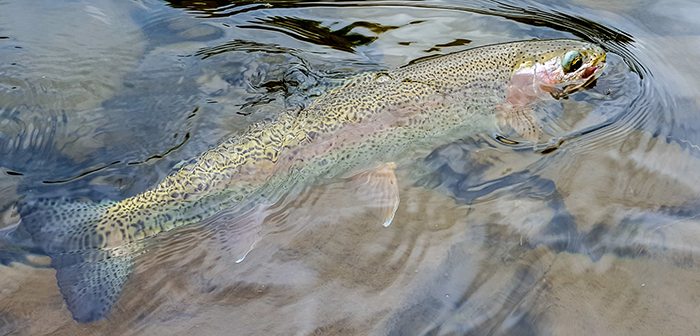 It’s my pleasure to post today the first of a two-part People of Fly Fishing interview with author Stephen Sautner.
It’s my pleasure to post today the first of a two-part People of Fly Fishing interview with author Stephen Sautner.
Stephen has been an active contributor to The New York Times “Outdoors” column. His stories have also appeared in The New York Times Magazine, Fly Rod & Reel, Angler’s Journal, Outdoor Life and Underwater Naturalist. He is the director of communications for the Wildlife Conservation Society at the Bronx Zoo, where he publicizes the Society’s conservation programs. His most recent book is “A Cast in the Woods: A Story of Fly Fishing, Fracking, and Floods in the Heart of Trout Country (see it here).”
All images per Jim Leedom by the way.
Please tell us a bit about your fly fishing bona fides – what were your first exposures to fly fishing what kept you coming back for more?
I was raised in New Jersey. By the time I was in my mid 20s, I was a serious angler, but I only fly-fished once or twice, and frankly I didn’t really care for it. At the time, I thought it was an unnecessarily complicated way to catch the fish I liked to catch, namely bass, stocked trout, and bluefish. Then one day, I went on a canoe trip on the Upper Delaware River in the Catskills and brought along a six weight Orvis Superfine I had bought off a friend who was unloading some gear on the super cheap. I had spent some time learning to cast it in my backyard and was starting to get the hang of it, so I brought it along.
On the river, I happened upon my first ever hatch and a few large trout rising in this swift run hard against an island. I remember the day so well; how the line shot through the guides and how the fly touched down and the one fish that came up for it. It turned out to be a 16-inch wild rainbow, which went absolutely berserk. Never had I seen a fish fight in such a crazed way – the multiple jumps and insane runs. Unfortunately, it broke me off, but it was like I was shot by a lightning bolt. I knew that this is what I wanted to do from now on, and I have largely followed that dream. But I don’t just fly fish for trout, I fish for false albacore and stripers, American shad, salmon, even carp with my fly rod (s) – at last check I owned 15 or so.
Please share what about the Catskills first attracted you as an angler?
Besides the historical aspects of the Castkills as the cradle of American fly fishing, it is an incredibly beautiful, haunting place to fish. The dark, eastern forests teem with wildlife; the complicated hatches; and of course the wild trout that thrive there. I have caught wild trout from Alaska to Tierra del Fuego, and to my mind, pound for pound nothing fights as hard as a wild rainbow or brown on the Upper Delaware. I’m not sure why that is, but it’s true and I am not alone feeling that way.
What in particular about your Catskills journey was it that sparked the inspiration for A Cast in the Woods?
The Upper Delaware is nearly three hours from my home in New Jersey. So in 2003, my wife and I decided to buy a cabin simply so we could fish more and drive less. We wound up buying a hunting camp built in the 1940s that sat on 14 acres of woods and had a quarter mile of a small Delaware tributary running through it. Right after we bought it, a series of events – three historic floods in as many years followed by the rush for fracking of natural gas in the region – forced us to become defenders, advocates, and stewards of our property. This involved restoring the flood ravaged stream to save its wild brookies and migratory rainbows, and to becoming an activist against natural gas drilling, which I felt would destroy the area’s river sand streams.
You’ve traveled and fish to a number of places around the world; what’s been your most memorable fly fishing adventure on the road?
My day job at the Wildlife Conservation Society has allowed me to travel to some exotic places, and I often sneak a pack rod in my luggage just in case. The most interesting place was the Falkland Islands where I got to fish for sea run browns next to a minefield leftover from the war in the 1982 between the British and Argentina. I caught a few small browns which was fun, but the coolest fish was something called a Falklands mullet. It readily hits flies, bulldogs like a redfish and jumps like a snook. And it’s delicious. They run as large as 20 pounds, though the biggest one I caught may have weighed three. If they occurred in local waters in the northeast, everyone would fish for them.
What do you consider your prime regional water and what about it keeps you coming back time after time?
The Delaware River and its tributaries continue to suck me in. To me, the Delaware acts just as a river should with wild trout in its headwaters, cool-water fish like smallmouth and walleye in its middle reaches and anadromous fish like American shad and stripers running unfettered because there are no dams on its main stem. But local saltwater pulls me, too – particularly in the fall when stripers, bluefish and false albacore run along our beaches.
We’ll be back with part 2 of Stephen’s interview on Thursday.


